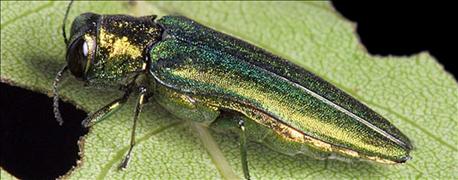June 9, 2016

Yesterday, the Nebraska Department of Agriculture (NDA) confirmed the first find in the state of emerald ash borer (EAB), an invasive beetle that attacks and kills all species of ash trees, in a tree located in Pulaski Park in southeast Omaha. Nebraska will be the 27th state to confirm the presence of the pest since 2002. EAB has killed hundreds of millions of ash trees in 26 states. It is projected that Nebraska's taxpayers and homeowners will spend over $961 million on ash tree removal, disposal and replacement.

EAB IN NEBRASKA: Emerald ash borer is a small, metallic-green beetle, about one-half inch long. The larvae of this wood-boring insect tunnel under the bark of ash trees, disrupting the flow of water and nutrients, ultimately causing the tree to die.
EAB is a small, metallic-green beetle, about one-half inch long. The larvae of this wood-boring insect tunnel under the bark of ash trees, disrupting the flow of water and nutrients, ultimately causing the tree to die. EAB-infested ash trees will exhibit thinning or dying branches in the top of the tree, S-shaped larval galleries under bark, D-shaped exit holes, and suckers along the trunk and main branches.
"While it is unfortunate that we have confirmation of the pest in Nebraska, it is not unexpected – considering the close proximity to confirmed pest infestations in Iowa, Missouri and Kansas," said NDA Director Greg Ibach. "The Nebraska Department of Agriculture, along with the United States Department of Agriculture, the Nebraska Forest Service and members of the Nebraska EAB Working Group have been preparing for the possibility this pest would enter the state."
NDA has issued a quarantine prohibiting ash nursery stock from leaving the quarantine area. The quarantine also regulates the movement of hardwood firewood and mulch, ash timber products and green waste material out of Douglas, Sarpy, Cass, Washington and Dodge counties to assist in the prevention of human-assisted spread of the pest into un-infested areas. A USDA quarantine is also expected, and NDA and USDA staff will work with the public and impacted industries to ensure compliance of the quarantines. NDA staff will continue to set and monitor EAB traps across the state to monitor for additional infestations.
"Now is a good time for residents in and around Omaha – and municipalities throughout the state – to take proactive steps to deal with EAB," said Deputy State Forester John Erixson. "Once EAB is found in an area, most ash trees are killed within 10-15 years."
~~~PAGE_BREAK_HERE~~~
Residents with ash trees in the Omaha area may want to begin treatments. According to Mark Harrell, Forest Health Program Leader with the Nebraska Forest Service, the best candidates for treatments are healthy, high-value trees that are in a good location. Other trees – those in poor conditions or located under wires or too close to sidewalks or buildings, should be removed instead of treated.
"Treatments need to be applied every one to two years and must be done for the remaining life of the tree," said Harrell. "For this reason, many trees will not be worth saving."
Owners of ash trees outside of the Omaha area may be anxious to begin treatments, but the recommendation is still to wait until EAB has been found within 15 miles of your trees. The chance that your tree will be the first one infested is very low, especially if it is well cared for. The current treatment consideration zone extends from Fort Calhoun to Plattsmouth and from Gretna to east of Council Bluffs.
However, the Nebraska Forest Service advises municipalities and anyone else managing large numbers of ash trees to take steps now to prepare for EAB – even if they are outside of the Omaha area.
"Upwards of 80% of the ash trees will die within 8 years after EAB is found in a community if nothing is done to manage the pest," said Eric Berg, Program Leader for Community Forestry and Sustainable Landscapes. "This can put a strain on city budgets and staff and create liability issues if dead trees are left standing. Nebraska municipalities need to be proactive in dealing with EAB."
The Nebraska EAB working group offers the following suggestions to help prevent the human-assisted spread of the pest:
• Use locally-sourced firewood, burning it in the same county where you purchased it. Firewood is a transportation vessel for the pest.
• Only high value ash tress located within 15 miles of a known infestation should be considered for treatment. Trees that are experiencing declining health should be considered for removal.
• If you feel you have located an EAB infestation, please report it to the Nebraska Department of Agriculture at (402) 471-2351, the Nebraska Forest Service at (402) 472-2944 or your local USDA office at (402) 434-2345.
Additional information on EAB, including the quarantine information, can be found at the NDA website. Additional information on EAB and Nebraska specific recommendations and guidelines can be found at www.eabne.info.
Sources: Nebraska Department of Agriculture, Nebraska Forest Service
You May Also Like




